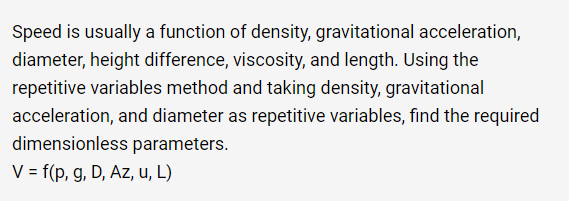Speed is usually a function of density, gravitational acceleration, diameter, height difference, viscosity, and length. Using the repetitive variables method and taking density, gravitational acceleration, and diameter as repetitive variables, find the required dimensionless parameters. V = f(p, g, D, Az, u, L)
Speed is usually a function of density, gravitational acceleration, diameter, height difference, viscosity, and length. Using the repetitive variables method and taking density, gravitational acceleration, and diameter as repetitive variables, find the required dimensionless parameters. V = f(p, g, D, Az, u, L)
Principles of Heat Transfer (Activate Learning with these NEW titles from Engineering!)
8th Edition
ISBN:9781305387102
Author:Kreith, Frank; Manglik, Raj M.
Publisher:Kreith, Frank; Manglik, Raj M.
Chapter6: Forced Convection Over Exterior Surfaces
Section: Chapter Questions
Problem 6.32P
Related questions
Question
100%

Transcribed Image Text:Speed is usually a function of density, gravitational acceleration,
diameter, height difference, viscosity, and length. Using the
repetitive variables method and taking density, gravitational
acceleration, and diameter as repetitive variables, find the required
dimensionless parameters.
V = f(p, g, D, Az, u, L)
Expert Solution
This question has been solved!
Explore an expertly crafted, step-by-step solution for a thorough understanding of key concepts.
Step by step
Solved in 4 steps with 4 images

Knowledge Booster
Learn more about
Need a deep-dive on the concept behind this application? Look no further. Learn more about this topic, mechanical-engineering and related others by exploring similar questions and additional content below.Recommended textbooks for you

Principles of Heat Transfer (Activate Learning wi…
Mechanical Engineering
ISBN:
9781305387102
Author:
Kreith, Frank; Manglik, Raj M.
Publisher:
Cengage Learning

Principles of Heat Transfer (Activate Learning wi…
Mechanical Engineering
ISBN:
9781305387102
Author:
Kreith, Frank; Manglik, Raj M.
Publisher:
Cengage Learning